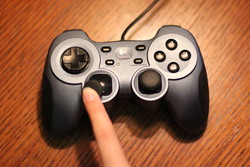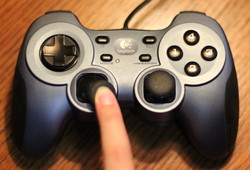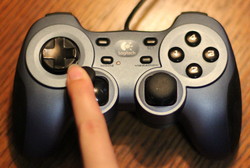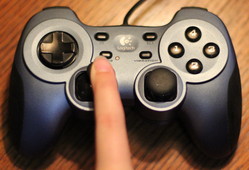19. User Control¶
How do we interact with the user? Get the user to move an object on the screen?
We can do this with the mouse, with the keyboard, or with the game controller.
19.1. Move with the Mouse¶
The key to managing mouse motion to override the on_mouse_motion in the
arcade.Window class. That method is called every time the mouse moves.
The method definition looks like this:
def on_mouse_motion(self, x, y, dx, dy):
The x and y are the coordinates of the mouse. the dx and dy
represent the change in x and y since the last time the method was called.
Often when controlling a graphical item on the screen with the mouse, we do
not want to see the mouse pointer. If you don’t want to see the mouse pointer,
in the __init__ method, call the following method in the parent class:
self.set_mouse_visible(False)
The example below takes our Ball class, and moves it around the screen with
the mouse.
1 2 3 4 5 6 7 8 9 10 11 12 13 14 15 16 17 18 19 20 21 22 23 24 25 26 27 28 29 30 31 32 33 34 35 36 37 38 39 40 41 42 43 44 45 46 47 48 49 50 51 52 53 | import arcade
SCREEN_WIDTH = 640
SCREEN_HEIGHT = 480
class Ball:
def __init__(self, position_x, position_y, radius, color):
# Take the parameters of the init function above, and create instance variables out of them.
self.position_x = position_x
self.position_y = position_y
self.radius = radius
self.color = color
def draw(self):
""" Draw the balls with the instance variables we have. """
arcade.draw_circle_filled(self.position_x, self.position_y, self.radius, self.color)
class MyGame(arcade.Window):
def __init__(self, width, height, title):
# Call the parent class's init function
super().__init__(width, height, title)
# Make the mouse disappear when it is over the window.
# So we just see our object, not the pointer.
self.set_mouse_visible(False)
arcade.set_background_color(arcade.color.ASH_GREY)
# Create our ball
self.ball = Ball(50, 50, 15, arcade.color.AUBURN)
def on_draw(self):
""" Called whenever we need to draw the window. """
arcade.start_render()
self.ball.draw()
def on_mouse_motion(self, x, y, dx, dy):
""" Called to update our objects. Happens approximately 60 times per second."""
self.ball.position_x = x
self.ball.position_y = y
def main():
window = MyGame(640, 480, "Drawing Example")
arcade.run()
main()
|
19.2. Mouse Clicks¶
You can also process mouse clicks by defining an on_mouse_press method:
def on_mouse_press(self, x, y, button, modifiers):
""" Called when the user presses a mouse button. """
if button == arcade.MOUSE_BUTTON_LEFT:
print("Left mouse button pressed at", x, y)
elif button == arcade.MOUSE_BUTTON_RIGHT:
print("Right mouse button pressed at", x, y)
19.3. Move with the Keyboard¶
Moving with the game controller is similar to our bouncing ball example. There are just two differences:
We control the
change_xandchange_ywith the keyboardWhen we hit the edge of the screen we stop, rather than bounce.
To detect when a key is hit, we override the on_key_press method. We might
think of hitting a key as one event. But it is actually two. When the key is
pressed, we start moving. When the key is released we stop moving. That makes
for two events. Releasing a key is controlled by on_key_release.
These methods have a key variable as a parameter that can be compared with
an if statement to the values in
the arcade.key library.
def on_key_press(self, key, modifiers):
if key == arcade.key.LEFT:
print("Left key hit")
elif key == arcade.key.A:
print("The 'a' key was hit")
We can use this in a program to move a ball around the screen. See the highlighted lines in the program below:
1 2 3 4 5 6 7 8 9 10 11 12 13 14 15 16 17 18 19 20 21 22 23 24 25 26 27 28 29 30 31 32 33 34 35 36 37 38 39 40 41 42 43 44 45 46 47 48 49 50 51 52 53 54 55 56 57 58 59 60 61 62 63 64 65 66 67 68 69 70 71 72 73 74 75 76 77 | import arcade
SCREEN_WIDTH = 640
SCREEN_HEIGHT = 480
MOVEMENT_SPEED = 3
class Ball:
def __init__(self, position_x, position_y, change_x, change_y, radius, color):
# Take the parameters of the init function above, and create instance variables out of them.
self.position_x = position_x
self.position_y = position_y
self.change_x = change_x
self.change_y = change_y
self.radius = radius
self.color = color
def draw(self):
""" Draw the balls with the instance variables we have. """
arcade.draw_circle_filled(self.position_x, self.position_y, self.radius, self.color)
def update(self):
# Move the ball
self.position_y += self.change_y
self.position_x += self.change_x
class MyGame(arcade.Window):
def __init__(self, width, height, title):
# Call the parent class's init function
super().__init__(width, height, title)
# Make the mouse disappear when it is over the window.
# So we just see our object, not the pointer.
self.set_mouse_visible(False)
arcade.set_background_color(arcade.color.ASH_GREY)
# Create our ball
self.ball = Ball(50, 50, 0, 0, 15, arcade.color.AUBURN)
def on_draw(self):
""" Called whenever we need to draw the window. """
arcade.start_render()
self.ball.draw()
def update(self, delta_time):
self.ball.update()
def on_key_press(self, key, modifiers):
""" Called whenever the user presses a key. """
if key == arcade.key.LEFT:
self.ball.change_x = -MOVEMENT_SPEED
elif key == arcade.key.RIGHT:
self.ball.change_x = MOVEMENT_SPEED
elif key == arcade.key.UP:
self.ball.change_y = MOVEMENT_SPEED
elif key == arcade.key.DOWN:
self.ball.change_y = -MOVEMENT_SPEED
def on_key_release(self, key, modifiers):
""" Called whenever a user releases a key. """
if key == arcade.key.LEFT or key == arcade.key.RIGHT:
self.ball.change_x = 0
elif key == arcade.key.UP or key == arcade.key.DOWN:
self.ball.change_y = 0
def main():
window = MyGame(640, 480, "Drawing Example")
arcade.run()
main()
|
19.3.1. Keep From Moving Off Screen¶
Unfortunately in the prior program, there is nothing that keeps the player from moving off-screen. If we want to stop the player from moving off-screen we need some additional code.
We detect the edge by comparing position_x with the left and right side
of the screen For example:
if self.position_x < 0:
But this isn’t perfect. Because the position specifies the center of the ball, by the time the x coordinate is 0 we are already have off the screen. It is better to compare it to the ball’s radius:
if self.position_x < self.radius:
What do we do once it hits the edge? Just set the value back to the edge:
# See if the ball hit the edge of the screen. If so, change direction
if self.position_x < self.radius:
self.position_x = self.radius
Here’s a full example:
1 2 3 4 5 6 7 8 9 10 11 12 13 14 15 16 17 18 19 20 21 22 23 24 25 26 27 28 29 30 31 32 33 34 35 36 37 38 39 40 41 42 43 44 45 46 47 48 49 50 51 52 53 54 55 56 57 58 59 60 61 62 63 64 65 66 67 68 69 70 71 72 73 74 75 76 77 78 79 80 81 82 83 84 85 86 87 88 89 90 | import arcade
SCREEN_WIDTH = 640
SCREEN_HEIGHT = 480
MOVEMENT_SPEED = 3
class Ball:
def __init__(self, position_x, position_y, change_x, change_y, radius, color):
# Take the parameters of the init function above, and create instance variables out of them.
self.position_x = position_x
self.position_y = position_y
self.change_x = change_x
self.change_y = change_y
self.radius = radius
self.color = color
def draw(self):
""" Draw the balls with the instance variables we have. """
arcade.draw_circle_filled(self.position_x, self.position_y, self.radius, self.color)
def update(self):
# Move the ball
self.position_y += self.change_y
self.position_x += self.change_x
# See if the ball hit the edge of the screen. If so, change direction
if self.position_x < self.radius:
self.position_x = self.radius
if self.position_x > SCREEN_WIDTH - self.radius:
self.position_x = SCREEN_WIDTH - self.radius
if self.position_y < self.radius:
self.position_y = self.radius
if self.position_y > SCREEN_HEIGHT - self.radius:
self.position_y = SCREEN_HEIGHT - self.radius
class MyGame(arcade.Window):
def __init__(self, width, height, title):
# Call the parent class's init function
super().__init__(width, height, title)
# Make the mouse disappear when it is over the window.
# So we just see our object, not the pointer.
self.set_mouse_visible(False)
arcade.set_background_color(arcade.color.ASH_GREY)
# Create our ball
self.ball = Ball(50, 50, 0, 0, 15, arcade.color.AUBURN)
def on_draw(self):
""" Called whenever we need to draw the window. """
arcade.start_render()
self.ball.draw()
def update(self, delta_time):
self.ball.update()
def on_key_press(self, key, modifiers):
""" Called whenever the user presses a key. """
if key == arcade.key.LEFT:
self.ball.change_x = -MOVEMENT_SPEED
elif key == arcade.key.RIGHT:
self.ball.change_x = MOVEMENT_SPEED
elif key == arcade.key.UP:
self.ball.change_y = MOVEMENT_SPEED
elif key == arcade.key.DOWN:
self.ball.change_y = -MOVEMENT_SPEED
def on_key_release(self, key, modifiers):
""" Called whenever a user releases a key. """
if key == arcade.key.LEFT or key == arcade.key.RIGHT:
self.ball.change_x = 0
elif key == arcade.key.UP or key == arcade.key.DOWN:
self.ball.change_y = 0
def main():
window = MyGame(640, 480, "Drawing Example")
arcade.run()
main()
|
19.4. Moving with the Game Controller¶
Working with game controllers is a bit more complex. A computer might not have any game controllers, or it might have five controllers plugged in.
We can get a list of all game pads that are plugged in with the
get_joysticks function. This will either return a list, or it will return
nothing at all if there are no game pads.
Below is a block of code that can be put in an __init__ method for your
application that will create an instance variable to represent a game pad
if one exists.
joysticks = arcade.get_joysticks()
if joysticks:
self.joystick = joysticks[0]
self.joystick.open()
else:
print("There are no joysticks.")
self.joystick = None
19.5. Joystick Values¶
After this, you can get the position of the game controller joystick by calling
self.joystick.x and self.joystick.y.
Try this, combined with the initialization code from above:
1 2 3 4 5 6 7 8 9 10 11 12 13 14 15 16 17 18 19 20 21 22 23 24 25 26 27 28 29 30 31 32 33 34 35 36 37 38 39 40 41 42 43 44 45 46 47 48 49 50 51 52 53 54 55 56 57 58 59 60 61 62 63 64 65 66 67 68 69 70 71 72 73 74 75 76 77 78 79 80 81 82 83 84 85 86 87 88 89 | import arcade
SCREEN_WIDTH = 640
SCREEN_HEIGHT = 480
MOVEMENT_SPEED = 5
DEAD_ZONE = 0.02
class Ball:
def __init__(self, position_x, position_y, change_x, change_y, radius, color):
# Take the parameters of the init function above, and create instance variables out of them.
self.position_x = position_x
self.position_y = position_y
self.change_x = change_x
self.change_y = change_y
self.radius = radius
self.color = color
def draw(self):
""" Draw the balls with the instance variables we have. """
arcade.draw_circle_filled(self.position_x, self.position_y, self.radius, self.color)
def update(self):
# Move the ball
self.position_y += self.change_y
self.position_x += self.change_x
# See if the ball hit the edge of the screen. If so, change direction
if self.position_x < self.radius:
self.position_x = self.radius
if self.position_x > SCREEN_WIDTH - self.radius:
self.position_x = SCREEN_WIDTH - self.radius
if self.position_y < self.radius:
self.position_y = self.radius
if self.position_y > SCREEN_HEIGHT - self.radius:
self.position_y = SCREEN_HEIGHT - self.radius
class MyGame(arcade.Window):
def __init__(self, width, height, title):
# Call the parent class's init function
super().__init__(width, height, title)
# Make the mouse disappear when it is over the window.
# So we just see our object, not the pointer.
self.set_mouse_visible(False)
arcade.set_background_color(arcade.color.ASH_GREY)
# Create our ball
self.ball = Ball(50, 50, 0, 0, 15, arcade.color.AUBURN)
# Get a list of all the game controllers that are plugged in
joysticks = arcade.get_joysticks()
# If we have a game controller plugged in, grab it and
# make an instance variable out of it.
if joysticks:
self.joystick = joysticks[0]
self.joystick.open()
else:
print("There are no joysticks.")
self.joystick = None
def on_draw(self):
""" Called whenever we need to draw the window. """
arcade.start_render()
self.ball.draw()
def update(self, delta_time):
# Update the position according to the game controller
if self.joystick:
print(self.joystick.x, self.joystick.y)
def main():
window = MyGame(640, 480, "Drawing Example")
arcade.run()
main()
|
Run the program and see the values it prints out for your game controller as you move the joystick on it around.
The values will be between -1 and +1, with 0 being a centered joystick.
The x-axis numbers will be negative if the stick goes left, positive for right.
The y-axis numbers will be opposite of what you might expect. Negative for up, positive for down.

Centered (0, 0)¶

Down (0, 1)¶

Down/Left (-1, 1)¶

Down/Right (1, 1)¶

Up (0, -1)¶

Up/Left (-1, -1)¶

Up/Right (1, -1)¶
We can move the ball by adding the following code to the update:
def update(self, delta_time):
# Update the position according to the game controller
if self.joystick:
print(self.joystick.x, self.joystick.y)
self.ball.change_x = self.joystick.x
self.ball.change_y = -self.joystick.y
Notice the - we put in front of setting the y vector. If we don’t do this,
the ball will move opposite of what we expect when going up/down. This is because
the joystick has y values mapped opposite of how we’d normally expect. There’s
a long story to that, which I will not bore you with now.
But with this code our ball moves so slow. How do we speed it up? We can make it run five times faster by multiplying by five if we want.
def update(self, delta_time):
# Update the position according to the game controller
if self.joystick:
print(self.joystick.x, self.joystick.y)
self.ball.change_x = self.joystick.x * 5
self.ball.change_y = -self.joystick.y * 5
Or better yet, define a constant variable at the top of your program and use that. In our final example below, we’ll do just that.
19.6. Deadzone¶
What if your ball ‘drifts’ when you have the joystick centered?
Joysticks are mechanical. A centered joystick might have a value not at 0, but at 0.0001 or some small number. This will make for a small “drift” on a person’s character. We often counteract this by having a “dead zone” where if the number is below a certain value, we just assume it is zero to eliminate the drift.
See the highlighted lines for how we take care of the dead zone:
1 2 3 4 5 6 7 8 9 10 11 12 13 14 15 16 17 18 19 20 21 22 23 24 25 26 27 28 29 30 31 32 33 34 35 36 37 38 39 40 41 42 43 44 45 46 47 48 49 50 51 52 53 54 55 56 57 58 59 60 61 62 63 64 65 66 67 68 69 70 71 72 73 74 75 76 77 78 79 80 81 82 83 84 85 86 87 88 89 90 91 92 93 94 95 96 97 98 99 100 101 102 | import arcade
SCREEN_WIDTH = 640
SCREEN_HEIGHT = 480
MOVEMENT_SPEED = 5
DEAD_ZONE = 0.02
class Ball:
def __init__(self, position_x, position_y, change_x, change_y, radius, color):
# Take the parameters of the init function above, and create instance variables out of them.
self.position_x = position_x
self.position_y = position_y
self.change_x = change_x
self.change_y = change_y
self.radius = radius
self.color = color
def draw(self):
""" Draw the balls with the instance variables we have. """
arcade.draw_circle_filled(self.position_x, self.position_y, self.radius, self.color)
def update(self):
# Move the ball
self.position_y += self.change_y
self.position_x += self.change_x
# See if the ball hit the edge of the screen. If so, change direction
if self.position_x < self.radius:
self.position_x = self.radius
if self.position_x > SCREEN_WIDTH - self.radius:
self.position_x = SCREEN_WIDTH - self.radius
if self.position_y < self.radius:
self.position_y = self.radius
if self.position_y > SCREEN_HEIGHT - self.radius:
self.position_y = SCREEN_HEIGHT - self.radius
class MyGame(arcade.Window):
def __init__(self, width, height, title):
# Call the parent class's init function
super().__init__(width, height, title)
# Make the mouse disappear when it is over the window.
# So we just see our object, not the pointer.
self.set_mouse_visible(False)
arcade.set_background_color(arcade.color.ASH_GREY)
# Create our ball
self.ball = Ball(50, 50, 0, 0, 15, arcade.color.AUBURN)
# Get a list of all the game controllers that are plugged in
joysticks = arcade.get_joysticks()
# If we have a game controller plugged in, grab it and
# make an instance variable out of it.
if joysticks:
self.joystick = joysticks[0]
self.joystick.open()
else:
print("There are no joysticks.")
self.joystick = None
def on_draw(self):
""" Called whenever we need to draw the window. """
arcade.start_render()
self.ball.draw()
def update(self, delta_time):
# Update the position according to the game controller
if self.joystick:
# Set a "dead zone" to prevent drive from a centered joystick
if abs(self.joystick.x) < DEAD_ZONE:
self.ball.change_x = 0
else:
self.ball.change_x = self.joystick.x * MOVEMENT_SPEED
# Set a "dead zone" to prevent drive from a centered joystick
if abs(self.joystick.y) < DEAD_ZONE:
self.ball.change_y = 0
else:
self.ball.change_y = -self.joystick.y * MOVEMENT_SPEED
self.ball.update()
def main():
window = MyGame(640, 480, "Drawing Example")
arcade.run()
main()
|